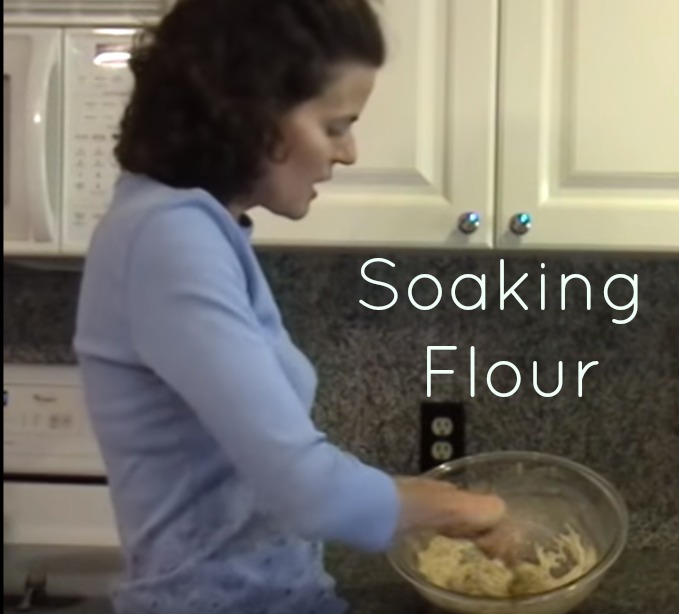Table of Contents[Hide][Show]
Soaking flour for maximum digestibility is one of the three traditional methods of grain preparation for healthy, nutritious bread as practiced by Ancestral cultures.
One of the most important baking techniques to learn when implementing a traditional diet is soaked flour. This ancestral method of grain preparation enhances digestibility and improves the metabolism of nutrients.
This technique also reduces anti-nutrients such as phytic acid in the grain flour. These substances block mineral absorption and can aggravate inflammation of the intestinal tract. Gluten-free grains also contain these anti-nutrients.
Other methods for reducing anti-nutrients in grains and improving metabolism include sour leavening (sourdough) and sprouting.
How to Soak Flour
Soaking flour is simple. Simply mix grain flour with yogurt, kefir, or clabbered milk, cover with a dishtowel, and let sit on the counter overnight. Freshly ground flour produces the best results. After the allotted soaking time, blend in the remaining ingredients and bake or cook as usual.
Non-grain based flours such as cassava and coconut flour do not need soaking. Others such as almond flour and chickpea flour are best soaked before grinding rather than after.
Dairy-Free
For those with milk allergies, substitute 1 cup of filtered water per cup of flour plus 2 TBL of lemon juice or apple cider vinegar and soak as usual for at least 8 hours or overnight.
For those with more extreme wheat sensitivities, the soaking time can be increased up to 24 hours to further breakdown gluten and other anti-nutrients.
Soaking any longer than 24 hours risks the development of mold.
Soaking Flour Technique Applies to All Grains
The principle of soaking can be applied to whole grains as well, such as your morning oatmeal. It was common to soak oats overnight before cooking back before WWII. This step was apparently even suggested on the Quaker oatmeal box!
It seems with the modern preference for speed in food preparation, this essential step has been lost. Hardly anyone under the age of 80 even remembers it anymore.
Try soaking your oatmeal the night before and see how much more filling it is after you cook and eat it the next morning.
Instead of being hungry again at 10 am, you will likely be full right through until lunch! To soak oatmeal, use 1 cup of warm filtered water per cup of oats plus 2 TBL whey, yogurt, kefir, or buttermilk. Stir together in the pot you will cook them in, cover with the lid, and leave overnight.
Cook, as usual, the next morning.
Bread Recipes Using Soaked Flour
Try this soaked bread recipe with your soaked flour. You can also try making a soaked loaf in a bread machine.
The video in the recipe tutorial below demonstrates visually the simple process of soaking flour. Try it with your next flour-based recipe!

How to Soak Flour
How to soak flour of all kinds before making the batter to improve digestibility and nutritional benefits of bread and other baked goods.
Ingredients
- 2 cups flour preferably freshly ground and organic
- 2 cups whole milk yogurt
Instructions
-
Mix flour and yogurt in a large bowl.
-
Cover with a clean dishcloth and secure with a large rubber band.
-
Leave on the counter overnight or for 8 hours.
-
Uncover, mix in remaining ingredients for whatever recipe you wish to make and bake as usual.
Recipe Video
Recipe Notes
Clabbered milk or plain kefir may be substituted for yogurt.
If there is a dairy allergy, 2 cups of water plus 2 Tbl lemon juice may be substituted. This reduces the calories to 910 for one batch.








Here's a good recipe for a soaked loaf bread: https://www.thehealthyhomeeconomist.com/kefir-soaked-sandwich-loaf/
I actually buy my loaf bread from the store: Berlin Bakery's Sourdough Spelt. I use soaking flour method in my kitchen more for specialty breads like banana bread, pancakes, waffles, that sort of thing.
Am planning to do the Video Thursday this week on sprouting wheat so stay tuned!
Hi Sarah your website is wounderful i wish i discovered it mush sooner. I have an autistic son and determent to do evrething i can for him……anyway i am a bit confused on the amount of ingridients i need to use if i am soking the flower?also this link/recepie has yeast in it, how do i go to do it with out yeast? if you can help i would really appresiate it. thank you, anna
Hi Sarah! I too am new to your blog and am mildly addicted! I have been feeling for a while that I have a grain intolerance, so I am absolutely going to try this method out. I also grind my flour/make bread but with a mixer/loaf pans vs. bread machine. Do you soak your flour before making traditional loaf bread?
Oh, one more thing…..where can I find the info you mentioned about sprouting grains?
Sorry so many questions and thanks again for your time!
Thank you so much for your posts. These videos are so extremely helpful. I can't wait to see the others on traditional methods of preparing grains. I'd love to have a segment on grinding your wheat. (Maybe you've already done that and I missed it?)
Teresa Zeller
I am new to all of this. I guess "instant gratification" is my new nemesis. I love that I do not have to "re-pioneer" all of this information. Thanks so much Sarah for being there presenting this information to those of us who want the best for ourselves and our families.
Hi Dorsey, I wrote an article a few years back for Wise Traditions magazine on uses for raw milk that has soured and is no longer drinkable but still highly usable. Here a link to the article:
https://www.westonaprice.org/health-topics/food-features/learning-to-maximize-the-use-of-your-real-milk-and-cream/
Breadmaking machines are really designed to make bread the modern way using yeast .. not for traditionally prepared breads which is why they do not work particularly well for a soaked bread. Better to use a glass loafpan for a soaked bread. The liquid used for soaking the oatmeal overnight is all absorbed by the time you are ready to cook, so no need to pour anything off, just add additional liquid as necessary and cook.
Can you make bread in a breadmaker with soaked flour? What would the measurements be? Would I just skip the soaking liquid and continue with the recipe? Very new to this, and also wonder what I do with the liquid if I soaked oatmeal for breakfast the night before, do I drain it or cook the oatmeal in the liquid? Sorry for so many questions but this is so new to me.
Duh Dorsey! I have been soaking my flour but my knowledge is very limited. Thanks so much for showing various ways to accomplish this. I had always done the kefir and water soak but loved the idea of using my soured milk.I never even thought of that. I have always been a bit stressed when my milk goes sour as I don't know the many ways it can be used. Now I see I can just start some flour soaking! Thanks big time.
Also…..maybe some video Thursday you can show us newbies some of the other ways to use raw milk that is past its prime. I would love to see that.
Fantastic, Rebecca. We really need to reach these young Moms the most. Please send it out to whomever you feel you benefit from the information.
Hey Sarah,
Great video this morning. I sent it out to all of my nieces as they are all young, stay at home mom's with a desire to feed their families well. I have been thinking recently about getting this type of info to 4-H and youth groups. This would be a good little video to shoot their way!